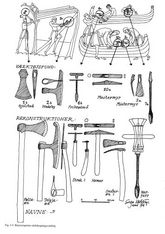Boat Builder (Filungar)
Unfortunately, we have no written source material describing how boat builders worked in Viking times. But in the sagas, law texts, and in Kongespejlet, an educational Norwegian text on good behaviour from a few hundred years later, we can read how the work of ship building was organised.
In Olav Trygvesons Saga, Snorre Sturlasson tells us about the building of the longship Ormen hin Lange in the 11th century:
Quote:“A lot of people were gathered for this work. Some felled trees, some dressed the timber, some made ship’s rivets, and others transported the timber.”
The distribution of work can be seen in Norwegian law texts, where it is clear that some craftsmen worked on the keel, the bow and the stern, and others with the planking.
The building of large and possibly royal ships, such as a longship like the Skuldelev 2, was led by a master shipbuilder called a Hofudsmidir. He was responsible for making sure that all the materials were on the building site or shipyard, and that the craftsmen got food and payment for their work.
The master builder could be fined if materials or tools went missing, if the shipbuilding was not completed on time or was not done correctly. The biggest fine, however, was for breaking up the old ship before the keel, bow and stern had been put together on the new ship.
The bow and stern smith (Stafnasmidir) was the most experienced boat builder on the site – the master shipbuilder’s right-hand man. He had the practical responsibility for the shape of the hull. As foreman on the building site, he received a higher wage than the ordinary boat builders, who were called Filungar.
The boat builder’s tools
The knowledge we have today about the tools of the boat builder is based on tools found in graves, archaeological excavations of towns and of shipyards where ships were built in Viking times, and pictures of boat builders with tools in their hands. One of these pictures is in the Bayeux Tapestry, an embroidered wall hanging from the 1070s in France. The picture shows a shipbuilding scene in which a man is dressing planks with a broad axe called a bredbil.
The largest find of tools is the Mästermyr box, which was excavated from a bog in Gotland, Sweden. The tools in the box suggest that the owner had been a metal craftsman and had worked in copper and iron. But the chest also contained a complete set of ship-building tools:
- 4 different kinds of axe
- 2 planes
- a drill
- a profile scraper
- a knife
- a chisel
- a hammer
- a rivet iron, for forging ship’s rivets.
The most interesting find from a dig in Denmark is from Over Hornbæk, near Randers, where a master shipbuilder lay buried with a broad axe inlaid with silver. Moreover, near Dejbjerg in West Jutland, a set of tools was found which is assumed to be what every shipbuilder would have had, consisting of two axes, a drill, and smithy equipment.
Did the boat builder actually sail with the ship?
It is difficult to say whether the boat builder was part of the crew on board Viking warships. In Kongespejlet there is a list of equipment that a warship should have, and here the boat builder’s tools are mentioned: an ordinary craftsman’s axe, a gouge, a drill, and other tools which are not specified in detail. These tools could certainly be used for minor repairs on board ship, for example, a split in the planking.
By: Louise Kæmpe Henriksen
